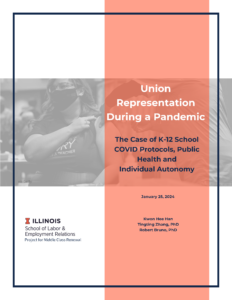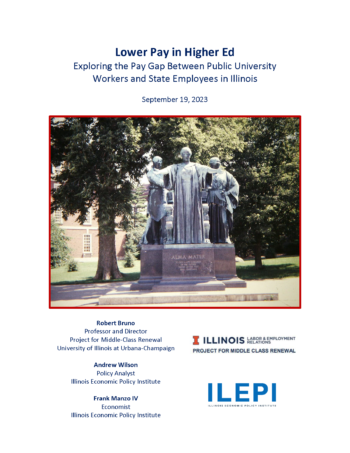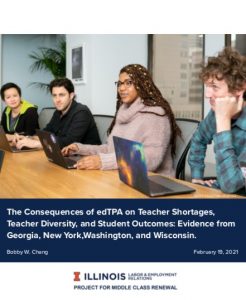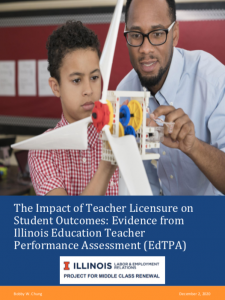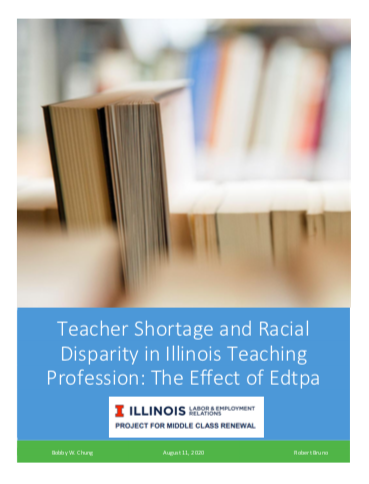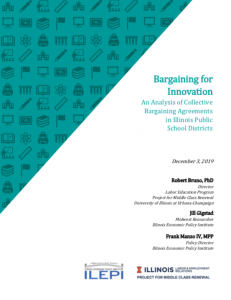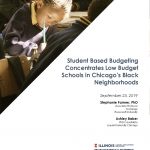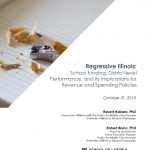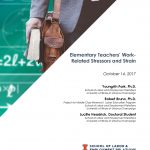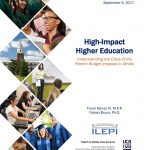
Education
UNION REPRESENTATION DURING A PANDEMIC | The Case of K-12 School COVID Protocols, Public Health and Individual Autonomy
The COVID-19 pandemic has had a profound effect on the Illinois educational workforce, creating a complex interplay between public health measures, individual autonomy, and union dynamics. This report, based on a survey of Illinois Federation of Teachers (IFT) members, highlights these multifaceted responses to vaccine mandates and the intricate position of teachers’ unions during these unprecedented times.
Read full report here.
STUDY | Workers at Illinois’ Public Universities Earn Significantly Less than Peers in State Government
Workers at Illinois’ public universities are earning between 14% and 20% less than their counterparts employed directly by state government agencies, according to a first-of-its-kind study released by the Project for Middle Class Renewal (PMCR) at the University of Illinois at Urbana-Champaign and the Illinois Economic Policy Institute (ILEPI).
Read full report here.
THE CONSEQUENCES OF EDTPA ON TEACHER SHORTAGES, TEACHER DIVERSITY, AND STUDENT OUTCOMES
The Illinois State Board of Education (ISBE) mandated the educative Teacher Performance Assessment (edTPA), a performance-based assessment to evaluate teaching readiness, as a licensure requirement since July 2015. In the previous reports, we find that edTPA had negative impacts on new teachers and their students in Illinois. This report seeks to generalize the findings to four other early edTPA states – Georgia, New York, Washington, and Wisconsin. Washington and New York are the earliest states integrating edTPA into their licensure systems in 2014, whereas Georgia and Wisconsin adopted edTPA in 2015 and 2016.
THE IMPACT OF TEACHER LICENSURE ON STUDENT OUTCOMES: EVIDENCE FROM ILLINOIS EDUCATION TEACHER PERFORMANCE ASSESSMENT (EdTPA)
In 2015 Illinois mandated the education Teacher Performance Assessment (edTPA), a performance-based assessment to evaluate teaching readiness, as a part of the teacher licensure requirements. The new requirement aimed to benefit student learning by improving the teaching effectiveness of prospective teachers. This report estimates the effect of teachers hired after 2015 when edTPA was implemented on student test scores. We analyze the mathematics and reading scores of 4th and 8th graders documented in the National Assessment of Educational Progress (NAEP) from 2009 to 2017.
TEACHER SHORTAGE AND RACIAL DISPARITY IN ILLINOIS TEACHING PROFESSION: THE EFFECT OF EDTPA
The Illinois State Broad of Education (ISBE) mandated Teacher Performance Assessment (edTPA), a performance-based assessment to evaluate teaching readiness, as a part of the licensure requirements since July 2015. The new examination imposed significant monetary ($300-$1,200 per applicant) and time investments, which had a disproportionate effect on minority prospective teacher candidates. The impact of the test exacerbated the problem of teacher shortages and the lack of diversity employment in the Illinois teacher market. This report provides the first empirical evidence about the effect of edTPA on teacher employment and sheds light on racial disparity in the teaching profession in Illinois.
BARGAINING FOR INNOVATION | AN ANALYSIS OF COLLECTIVE BARGAINING AGREEMENTS IN ILLINOIS PUBLIC SCHOOL DISTRICTS
More than two million children attend over 3,800 public schools in 852 local school districts across Illinois. Nearly all of these districts have collective bargaining agreements (CBAs) that determine the terms and conditions of employment. This study evaluates 543 collective bargaining agreements across Illinois, representing nearly two-thirds of all school district CBAs. While labor agreements establish enforceable terms upon the employees and the school districts, the analysis provides an understanding of how the contents of teacher labor contracts contribute to innovation and collaboration within Illinois’ large public education system.
STUDENT BASED BUDGETING CONCENTRATES LOW BUDGET SCHOOLS IN CHICAGO’S BLACK NEIGHBORHOODS
In 2014, Chicago Public Schools (CPS) adopted a system-wide Student Based Budgeting model for determining individual school budgets. Our report examines the impact of Student Based Budgeting. Our findings show that CPS’ putatively color-blind Student Based Budgeting reproduces racial inequality by concentrating low budget public schools almost exclusively in Chicago’s Black neighborhoods. The clustering of low budget schools in low-income Black neighborhoods adds another layer of hardship in neighborhoods experiencing distress from depopulation, low incomes, and unaffordable housing.
REGRESSIVE ILLINOIS: SCHOOL FUNDING, DISTRICT-LEVEL PERFORMANCE, AND ITS IMPLICATIONS FOR REVENUE AND SPENDING POLICIES
While equitable funding of K-12 public school has become an acute issue in many states, Illinois ranks among the most inequitable in its mechanisms for dispersing revenues to school districts. Illinois property taxes are the primary means for financing schools. However, due to very low state general aid, many property owners pay very high property taxes to support their schools. Consequently, the need for increased state support comes at a time when legislators have repeatedly proposed to freeze property taxes permanently, or for two to four years. Additionally, statewide bills have been introduced since 2012 that would shift pension costs, currently picked up by the state (excluding Chicago), to school districts. This research report from the Project for Middle Class Renewal in the School of Labor and Employment Relations at the University of Illinois, Urbana-Champaign examines the relationship between school revenue and achievement levels in Illinois. We first examine data on local school districts from 2011-2012 to 2016-2017 to explore and illustrate how revenue and expenditures vary by rates of low-income students and other key indicators. We find at the district level, higher instructional spending is associated with statistically significant improvement in aggregate student proficiency levels, after controlling for disadvantage and other characteristics at the district level. This positive relationship generally parallels the findings of recent studies that have concluded that money does in fact matter for education.
ELEMENTARY TEACHERS’ WORK-RELATED STRESSORS AND STRAIN
International surveys conducted by the European Trade Union Committee for Education (ETUCE) found that teachers in their union suffer significantly from stress (ETUCE, 2011). Furthermore, survey data in the United States reveals that teaching is a “high stress” profession (Kyriacou, 2000). The harm caused by this stress is evident by the high rates of teacher attrition and teacher shortages. Despite these findings, teacher stress has yet to be examined over time. Also, researchers have yet to examine how the increasing use of communication technology (i.e., email, text messages) has impacted teachers’ well-being and job outcomes. It seems many teachers have to deal with constant pressure to respond to emails throughout the day. Many teachers even get email sent directly to their personal phone. This can disturb teachers even while they are away from work. These messages may make it more difficult for teachers to control their emotions, which may lead to increased stress and turnover intentions. In addition, they suffer stress from difficult students and inadequate school resources such as workplace social supports and school policies.
High-Impact Higher Education: Understanding the Costs of the Recent Budget Impasse in Illinois
Investing in higher education is a smart economic development policy that boosts incomes, supports employment, and grows the economy. Illinois has world-class public universities and community colleges that serve as economic engines in local communities. The recent budget crisis in Illinois, however, had negative impacts on public universities and community colleges in the state. This report assesses the positive economic impacts of public universities and colleges in Illinois and measures the costs of the two-year budget impasse.
